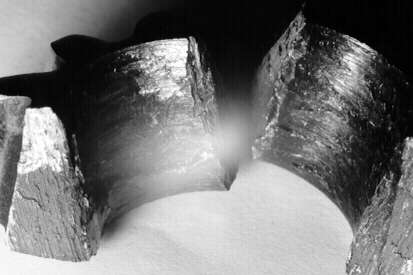The standard mini diff is a weak item. It does not like wheel spin at all. The more torque you have, or the faster you wheelspin, the shorter the life of the diff. There are two types of differential in the Mini, the A differential fitted to all cars from built before about 1981 or 2 and the A+ differential fitted to all cars bild after the changeover. Both differentials have essentially the same construction, but the A+ has one important difference. The copper thrust washers behind the spider gears have locating tags to prevent them turning. This dramatically improves the life of the differential.
There are a few failure modes that I know of. The first is simply wear. As the spider gears wear on the diff pin, they get loose. There are copper thrust washers behind the spider gears which for some reason do no wear very much. On the orginal A differential these washers are free to turn against the rather cast iron diff cage. For some reason, the cage wears quite dramatically while the copper remains largely intact. This wear allows the spider gears to get even looser. Eventually it gets too loose, and the gears jam and break.

The other possible failure mode is due to the roll pin that holds the main diff pin. This roll pin is made of sprung steel, unfortunatly it isn't strong enough. It can be crushed by the big diff pin which is trying to turn inside the housing. Once the roll pin is crushed, the big pin is free to slide out of the diff cage. It hits the aluminium of the gearbox casing and grinds its way through it. Eventually it comes out of the cage at one end and the diff jams and thats the end of your differential, and also your diff cover, which is nearly cut in half by this time.
I have had both these failures in less than a year. The diff blew shortly after I purchased the car and I rebuilt it with new diff pin, spider gears, fibre washers and copper washers. I used A+ type copper washers with locating tags (indeed, you can't get the pre A+ type anymore, you have to snip off the locating tags if you don't want them). This requires a slot filed in to the diff housing, it took a little while but was not difficult. If you put the washers into the diff, then it is obvious where the slot has to be filed. If you have access to many diff cages, then find the cage with the least wear under the copper washers, as the more wear here, the weaker the diff.
That diff lasted about a year and then my engine dropped a valve. When I took the engine apart I found the diff was about to blow big time. The roll pin had failed and the big pin was munching on the aluminium gearbox housing. The gearbox was FULL of aluminum filings. It didn't damage the engine, but I'm pritty sure it wore out my syncros.
Part of the reason that I experianced roll pin failure was that I incorrectly inserted it. You must drive the roll pin all the way into the housing. This means significantly below the surface of the housing. If you do not, then other end of the roll pin is more likely to get crushed. I did not push my pin in far enough, and when I stripped the diff later (I was rebuilding the gearbox so I checked the diff as well) I found that the far end had been crushed. Like a fool, I replaced the same half crushed pin in the opposite direction to use the non crushed end. I believe that if I had had used a new pin, properly inserted, I would not have had a catastrophic roll pin failure.
I now have a Mini Spares cross pin differential, which is said to be bullet proof... I hope so
If I ever build a standard diff again I will either use a piece of "silver steel", or more likely a drill bit, in place of the roll pin. If I do use a roll pin, it will definatly be a brand new one, and whatever I use, it will be pushed all the way into the housing!